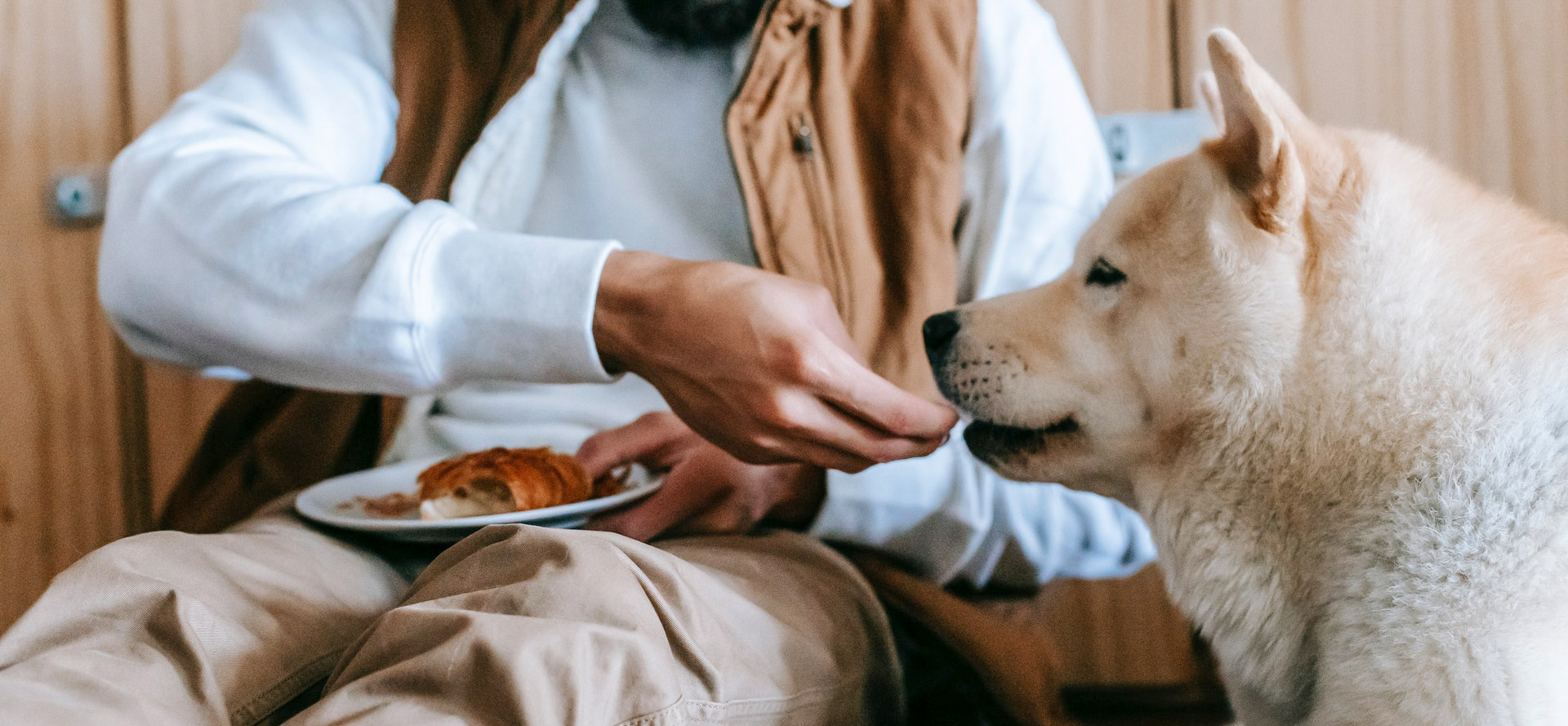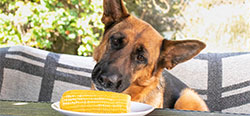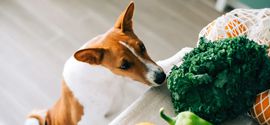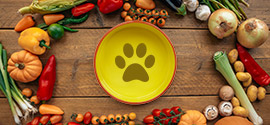Dog Feeding Guide: Tips & Mistakes

The questions of what is ok to eat, when to eat, and how much to eat suddenly become stressful when we have another living creature to take care of, like a dog. Particularly when we are new to caring for pets, it’s important to learn about appropriate feeding guidelines, so that our furry friends get what they need to be as healthy as possible. In this guide, we’ll explain how, when, and what to feed your dog, so that you don’t have to wonder.
General Guidelines
The first or second things that new pet parents tend to consider about food, perhaps after the type of diet or brand of food, are how much a dog needs to eat and when to feed them. Most dogs are smaller than the average adult human, and they may “ask” for food when they aren’t really hungry, so we have to understand how much food they need and when they need it, rather than relying on their cues.
How Much Food Dog Needs?
The amount of food that a dog needs depends on two major factors: size and activity level. Dogs need around 30 calories per pound of body weight per day to maintain their weight (just like humans, this can be adjusted slightly if weight needs to be gained or lost to reach a healthy size). At an average level of activity, toy dog breeds may need only 300 calories each day, while an average giant breed may need 2,000, which is the same caloric need as the average adult human. Working dogs, puppies, and dogs led on an active lifestyle by their owners will need more calories, while inactive dogs and older dogs may need fewer calories.
Best Time to Feed Dog
It is generally recommended that dogs eat two meals each day, roughly twelve hours apart, but the exact times aren’t as important. It’s a good idea to take their sleep schedule into account when possible so that they aren’t eating too close to bedtime, but if your own school or work schedule doesn’t allow it, don’t stress too much. Puppies and underweight dogs can be fed three meals instead, to help them maximize the absorption of nutrients and put weight on faster, but the total amount of food should not increase; instead, divide their daily recommended amount of food up into three portions.
What to Feed Your Dog?
People who don’t have dogs, and even some people who are quite familiar with dogs, often think that all dog food is the same and that it doesn’t matter what you feed them. This assumption is just as silly as saying that you can buy any food from the grocery store, and it will affect your body the same way! Dogs, like any animal, have specific nutritional needs, and not all foods are appropriate for all dogs.
Important Nutrients
Dogs depend on proteins, fats, and carbohydrates to fuel their body, roughly in that order. Proteins and fats are typically a dog’s primary energy source, but contrary to a popular myth, they should still eat a decent portion of carbohydrates unless allergies prevent it. Cooked whole grains, like whole-wheat pasta, are ideal. Vitamins A, B, D, C, E, and K are also critical in dogs’ diets, just like they are in ours. It’s important that a dog’s food both contains all of the key nutrients and is made from easily digestible ingredients to aid the absorption of the nutrients.
For Sensitive Stomachs
Any food can cause an allergy or sensitivity in a dog. Additionally, some dogs just have digestion problems, such as diarrhea.
If you suspect that your dog is sensitive to something in their food, consult your veterinarian about how to change their diet to avoid problematic ingredients. If your dog has a generally sensitive stomach and has issues with “standard” dog food, consider buying prescription food for sensitive stomachs (as recommended by their veterinarian) or cooking for them yourself. Homemade food consisting of high-quality, simple ingredients, like chicken, rice, and a micronutrient supplement, is sometimes the best answer for a dog with stomach problems.
What Food Not to Feed to Your Dog?
Despite evolving to live alongside humans and eat what we provide for them, dogs cannot eat everything that humans can. Everyone has heard of things like chocolate being bad for dogs, but the list of human foods that are bad for dogs is longer than you might think.
To keep your dog truly safe and healthy, you ought to know what dog foods and what human foods are likely to make them sick or cause problems.
Bad Dog Foods
Not all dog food is created equal. In order to be sold as “dog food” without encountering any legal issues, a product only has to meet certain minimum nutritional requirements, like protein and fat content.
If you’re on a tight budget, or if you’re not sure what makes a dog food high-quality, look for the closest to human-grade ingredients you can get and avoid labels with harmful preservatives and additives like:
- BHA
- BHT
- Ethoxyquin
- Carrageenan
- Propylene glycol
Toxic Human Foods
Some foods and ingredients that can be a normal part of a human diet, or even offer health benefits for us, can be toxic for our dogs. Although you should always check whether something is canine-friendly before sharing, just to be sure, these are some important ones to avoid:
- The onion family (onions, garlic, chives, etc.)
- Macadamia nuts
- Avocado
- Artificially sweetened foods (that use xylitol or other artificial sweeteners)
- Grapes and raisins
Conclusion
It may seem overwhelming to figure out all of the details of what should go into your dog’s diet. You want them to be a healthy weight, to feel good, and to enjoy their meals! Fortunately, once you get familiar with the general nutritional needs of dogs, the way their lifestyle affects these needs, and what types of food to avoid, it should be much simpler and faster to figure out what kind of food to give them. Remember that you can always consult your veterinarian about your pets’ diets if you aren’t sure. When you’re ready to start shopping, you can also check our thorough reviews to find some of the best-loved, most pet-expert-approved dog foods on the market.
FAQs
How much do you feed a dog?
You should always feed a dog the appropriate amount to help them maintain a healthy weight. For a dog that is a good size, this means a maintenance diet, which is around 30 calories per pound of body weight per day. This means a weight loss diet at a calorie deficit that your veterinarian can recommend for an overweight dog. For an underweight dog, this means a weight gain diet, at a calorie surplus that your veterinarian can recommend.
How much food should I feed my dog?
The amount of food that your dog needs depend on their size and their lifestyle. If you have a small dog, they may only need a few hundred calories every day, but if you have a large dog, they could need as many calories as you do! Most commercial dog foods have feeding recommendations based on the dog’s approximate weight. However, if you find that the recommendation is too much or too little for your dog, feel free to adjust it as needed.
How often should I feed my dog?
If you feed your dog two meals every day, which is the most common feeding plan, then they need roughly one meal every twelve hours. If they eat three meals, then the meals should be about six hours apart, so that the dog is not eating dinner immediately before bed.
How many times a day should I feed my dog?
The general recommendation is that dogs should eat two meals per day. If your dog is very young and still growing, or underweight and needs to eat a surplus, then eating three meals per day may make it easier for them to absorb the additional nutrients they need.
Can you feed a dog raw meat?
Dogs should never be fed raw food, as it is dangerous to them and to everyone in the household. Raw meat can contain dangerous bacteria that can make your dog severely ill. By feeding your dog raw meat, you are also putting your home at risk for contamination and, as a result, putting yourself and your household members at risk as well. Stick to commercially produced dog food or, if you prefer to make your dog’s food yourself, home-cooked meat and vegetables.
Tags: best pet supplies, is it bad for cats to eat flies, heated orthopedic dog beds, best dog bed for large dogs, large dog grooming table, safe dog toys, extra large outdoor dog kennel, pet ramp for dogs, best freeze dried dog food, dog clicker




